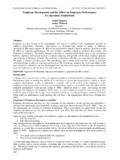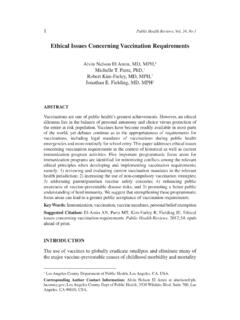Transcription of Media Effects on Crime and Crime Style - Harvard University
1 1 of 23 Media Effects on Crime and Crime Style Viridian Rios Department of Political Science Purdue University Draft: April 1st, 2018 Abstract Evidence about the relationship between exposure to Media violence and criminal activity remains mixed. While some scholars argue that exposure to violent Media contents "triggers" Crime and aggression, others contend that Media may influence Crime , but only as a source of information about techniques and styles (copycat), not as a motivation for Crime .
2 This debate has critical implications for criminal justice academics as calls for policy are regularly made on the bases of research in this area. This article contributes to this literature by presenting detailed, not self-reported, empirical evidence of how Media coverage of violent crimes affects crimes perpetrated by drug traffickers at the US-Mexico border, and their Crime Style . With an empirical model that addresses possible bidirectionalities between criminal violence and Media coverage, we tracked 31,676 homicides, its stylistic characteristics, and its coverage by the press.
3 Our results show that when Media covers criminal violence it influences the probability that other criminals use similar styles of crimes, but it does not change overall rates of criminal activity. This is evidence against the"trigger" hypothesis, and in favor of copycat Effects . Keywords: Violent Crime , Media violence, meta-analysis, aggression, US-Mexico border, traffickers. 2 of 23 A substantial and important portion of criminal justice research is concerned with environmental, situational, or systemic factors that cause, or are likely to cause, criminal behavior.
4 As part of this rich literature, the role that Media coverage has in shaping criminal behavior and beliefs about the justice system has long been an interest of criminal justice studies. In essence, there are two sides to the debate. The first, identified with the "General Aggression Model" (Bushman & Anderson, 2002; DeWall, Anderson, & Bushman, 2011), argues that exposure to Media coverage of violent crimes "triggers" the development of aggressive attitudes or behaviors and desensitizes people to actual violence (Greene & Bynum, 1982; Phillips & Hensley, 1984; Laser, Luster, & Oshio, 2007; Anderson, Bushman, Donnerstein, Hummer, & Warburton, 2015; Gentile, 2016).
5 In opposition to this first theory, advocates of theories such as "Uses and Gratifications" (Sherry, Lucas, Greenberg, & Lachlan, 2006) and "Self-Determination" (Przybylski, Rigby, & Ryan, 2010), have found no solid evidence of such Effects . These scholars feel more comfortable interpreting Media coverage of violent crimes as a "rudder" of Crime , meaning a factor that can shape criminal behavior, influencing, for example, the Style of a Crime ( copycat"), but does not cause it (Ferguson et al., 2008; Savage & Yancey, 2008; Doley et al.)
6 , 2013; Surette, 2013). Media coverage of violent crimes provide stylistic inspiration (Coyne, 2007; Surette, 2011, Surette, 2014; Surette, 2015; Ferguson & Colwell, 2017). Overall, evidence regarding the relationship between exposure to Media coverage of violent crimes, and violent Crime remains weak and mixed (Savage & Yancey, 2008; Doley et al., 2013). To advance these debate, scholars have identify the need to obtaining better measures (Coyne, 2007; Surette, 2014), exploring fictional and non-fictional Media portrayals (Ferguson et al.
7 , 2008; Savage & Yancey, 2008), and delving into different types of crimes (Surette, 2013). This paper contributes to advancing criminal justice literature by developing a study that addresses these concerns. We test the relationship between exposure to Media coverage of violent crimes, and violent Crime , using a uniquely detailed, non self-reported measures of Media coverage and criminal behaviour. Criminal justice researchers trying to quantitatively test the possible Effects of Media coverange of violent crimes may find interesting insights in our study because of the level of detail of the measures we gathered.
8 We recorded 31,676 homicides carried out by drug traffickers, and we measured the stylistic characteristics of each Crime , whether each of these homicides was covered by the Media , and how it was covered. This panel of 169 weeks allowed us to identify, for example, the share of drug traffickers homicides that were covered by the printed press, and whether the details of such crimes, including stylistic characteristics, were published. Importantly, Crime rates and rates of copycat Crime are not self-reported my offenders but obtained from official statistics.
9 The results of our study provide empirical evidence to sustain that "Uses and Gratifications" and "Self-Determination" theories are better positioned to explain how exposure to Media coverage of violent crimes affects criminal behaviour. When Media covers the violent crimes of drug traffickers, these do not by commit more violent crimes, but they do use similar Crime styles to the crimes that were covered by the press. In other words, traffickers are more prone to be copycats than to be triggered into violence by the Media . Our paper should be understood as part of a trend to conduct research in places outside the US, to enlighten relevant criminal justice debates.
10 For example, Brazil has been used to study psychopathy in criminal and forensic psychiatric populations (De Oliveira-Souza, Moll, Azecedo Ign cio, & Hare, 2008), England and Wales to identify triggers of violence in prisoners and forensic patients (Freestone, Ullrich, & Coid, 2017), Australia to validate the Ontario Domestic Assault Risk Assessment (Lauria, McEwan, Luebbers, Simmons, & Ogloff 2017), and China to test whether distributive justice and procedural justice are predictors of job satisfaction among community correctional staff (Jiang et al.)













